Menu
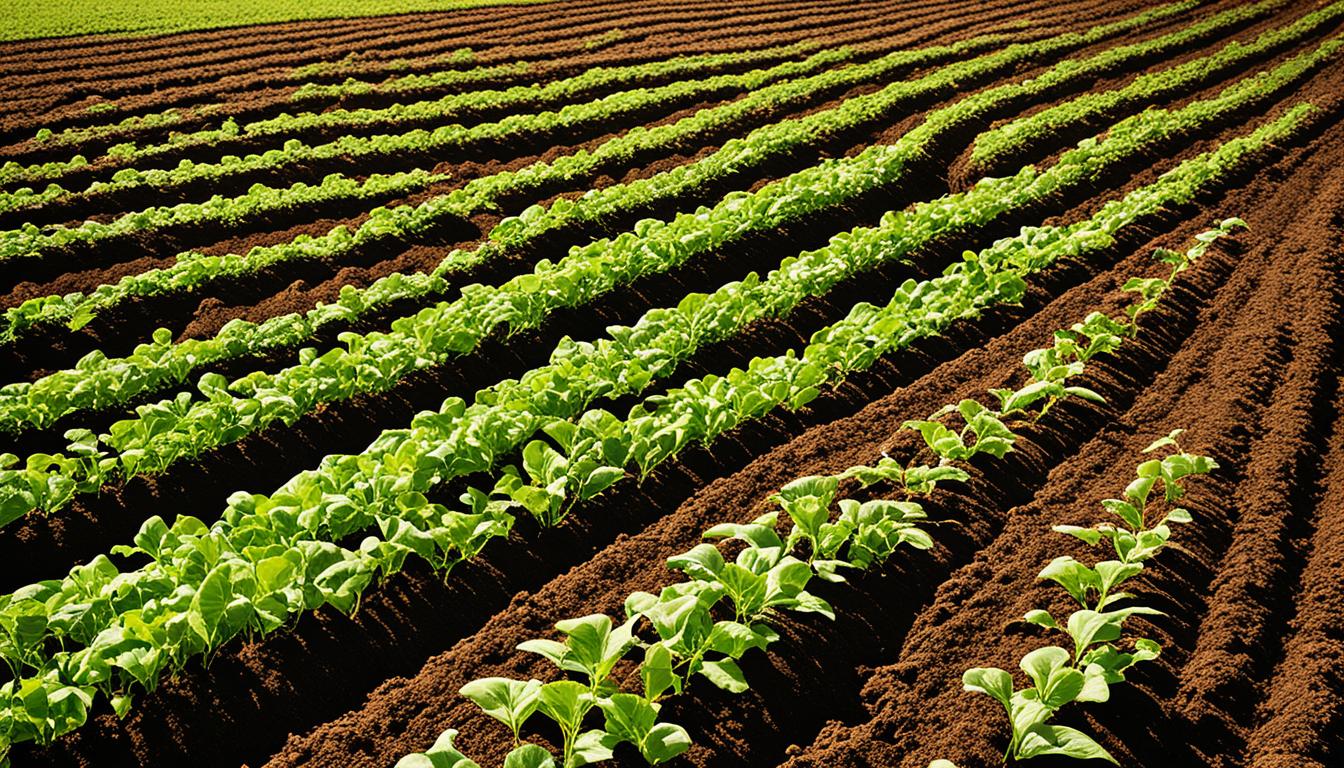
Did you know in 2012, biotechnology helped 88% of corn, 94% of cotton, and 93% of soybeans grow in the U.S.? This shows how crucial biotechnology is for improving agriculture. Especially in making soil healthier.
Biotechnology boosts sustainable farming. It takes care of the soil’s biological, chemical, and physical parts. This way, with new technology, soil stays a good place to grow crops.
Biotechnology helps make farms tough. They can handle tough conditions and still grow food. This includes using good genes, helpful microbes, and farming that’s good for the planet. In the end, it means we can farm and protect nature, making sure the soil is good for the future.
Biotechnology plays a vital role in making our soil healthier. It uses science and engineering to boost agricultural outcomes. This approach is key to making farming better for the environment and for us.
Biotechnology uses living organisms to create products or processes. Its effect on soil health is huge. It helps make crops stronger and more productive. Healthy soil supports plants and animals, helps clean water and air, and keeps us and the earth well.
By 2050, we might have 10 billion people. This means we need our soil and water to be healthy. Soil health is vital for farming to work well in the long run and to keep our planet healthy. New farming ways and crops that resist pests show the power of biotechnology in farming.
Biotechnology boosts how much crops produce. In the U.S., many crops are now made with biotechnology. These include most corn, cotton, and soybeans. They not only improved the crops but also made farming easier, saving time.
It also makes crops better at fighting off pests and diseases. For example, special cotton fights off bugs without needing as many pesticides. This helps keep our water clean and our environment safe. It also makes managing weeds easier, using safer chemicals that don’t stay in the soil as long.
Using less chemicals is better for our world. For instance, adding certain substances to the soil reduces the need for other fertilisers by 25%. This helps farming be more eco-friendly. It also makes food more nutritious and helps prevent the soil from getting worse.
Biotechnology brings a lot of good to farming. It boosts crop growth, makes plants tough against pests, and helps our environment. This approach is crucial for keeping our farming strong and our planet healthy.
Genetic engineering plays a key role in modern farming. It helps improve soil health by creating plants that fight off pests, diseases, and tough weather. CRISPR and gene editing are used to change the plants’ genetic code. This makes the soil and the plants healthier.
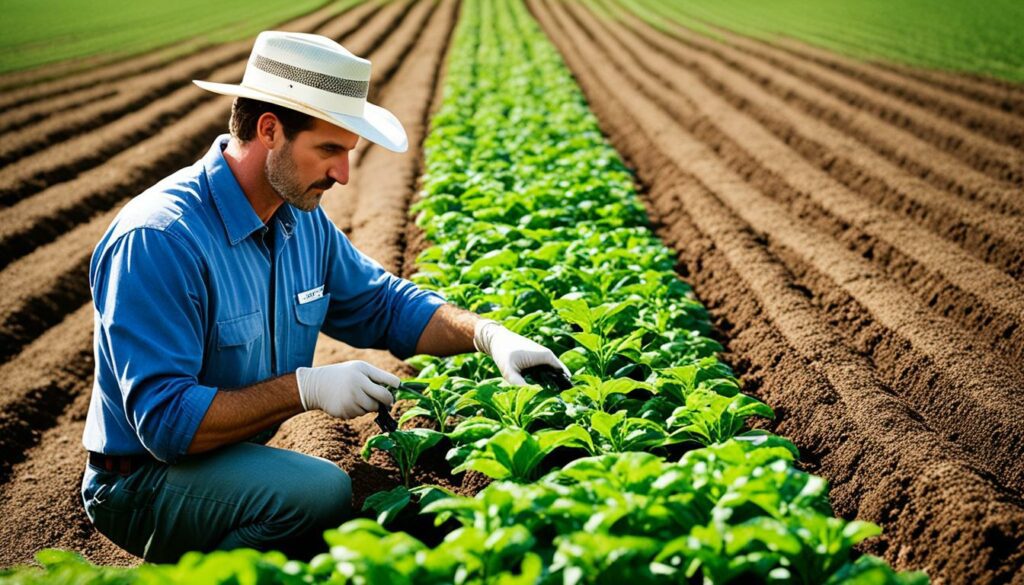
CRISPR and gene editing are important tools in farming. By using CRISPR, scientists can choose what parts of a plant’s genes to change.
This can make plants take in nutrients better and survive tough conditions. For example, it’s helped create crops that can stand herbicides. This means less soil is disturbed when farming.
In 2018, over 88.7 million hectares grew plants that could tolerate herbicides. Gene-edited crops can also help the soil work better. They can boost the activity of enzymes that help cycle nutrients like nitrogen.
Many studies show how genetic engineering improves soil and plant health. In the US in 2012, most corn, cotton, and soybeans were genetically engineered. These crops not only produced more but also improved the soil.
Research found that soil under certain genetically engineered plants did well. It didn’t hurt things like earthworms, microbes, or their activities. Instead, the soil’s ability to use nitrogen got better.
Reports from the USDA show that engineered crops are good for soil health. For example, they didn’t affect the work of soil decomposers. This means they help maintain a healthy ecosystem in the soil.
These findings highlight how crucial genetic engineering is for sustainable farming. Thanks to these tools, farmers can take better care of their soil. This leads to a farming future that’s both strong and productive.
Understanding soil microbiology helps us improve the health of the soil. It’s important because many different microorganisms live there. These include bacteria, fungi, viruses, and archaea.
By studying these tiny creatures and how they affect the soil, we learn how to make the soil healthier.
Knowing about soil microbiology is key. It shows us how small organisms help with many things like recycling nutrients, breaking down plant and animal matter, and fighting off harmful diseases.
This research proves that having a wide range of microorganisms in our soil is vital. It keeps the soil healthy and able to support plant life.
Nowadays, we can learn a lot about these microorganisms using special molecular methods (Bouchez et al., 2016). They let us see the hidden world of the soil and its microbes. This way, we can better understand how they help the soil do its job.
Diverse microorganisms in the soil bring many good things. They help keep the soil full of nutrients, break down dead plants and animals, and stop diseases from spreading.
Moreover, certain types of bacteria are really important for keeping the soil healthy (Jiao et al., 2019). They play a major part, especially when the environment is changing a lot.
| Benefit | Aspect Improved | Study |
|---|---|---|
| Enhanced Nutrient Cycling | Soil Health | Delgado-Baquerizo et al., 2016 |
| Organic Matter Decomposition | Ecosystem Functionality | Wagg et al., 2014 |
| Disease Suppression | Crop Resilience | Jiao et al., 2019 |
Seasons and the environment change how soil bacteria and viruses act (Roy et al., 2020). Understanding these changes is crucial for keeping soil life diverse and active.
So, using new technologies to encourage diverse microorganisms in the soil is crucial. It helps keep the soil healthy and improves farming.
Biotechnology is changing how we do farming sustainably. It connects modern and traditional farming. This is done through using organic farming biotechnology and integrated pest management. They help our soil and keep nature in balance.
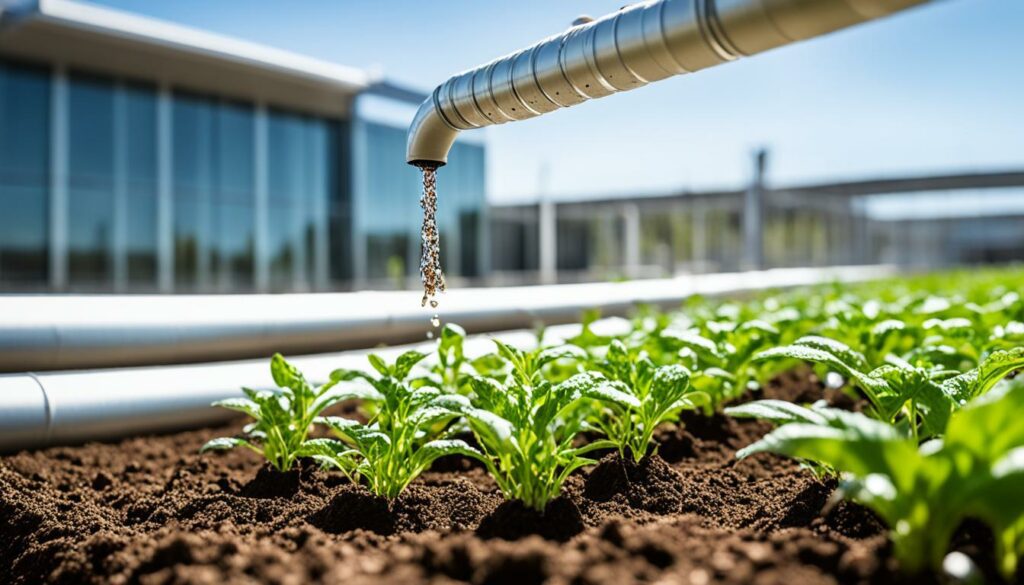
Organic farming relies on biofertilizers and biostimulants instead of chemical fertilizers. These help the soil stay healthy and keep crops growing well. It’s all about taking care of the earth for the future.
IPM looks at keeping pests under control with as few chemicals as possible. It mixes using natural enemies of insects with some safe chemicals. This way, we protect our crops without harming the planet.
| Practice | Biotechnological Application | Benefits |
|---|---|---|
| Organic Farming | Biofertilizers, Biostimulants | Improves soil health, reduces chemical use, enhances water retention |
| Integrated Pest Management | Pest-resistant crops, biological controls | Minimises chemical intervention, promotes ecological balance, increases crop resilience |
Soil biotechnology leads in making farming better. It makes crops grow more without hurting the environment.
Boosting how much food we can make is crucial. It’s because more people need food.Genetic engineering helps here. Things like Bt corn and cotton fight off bugs better, so we get more food.
In the U.S., a lot of crops are helped by this. For example, by 2012, most of the soybeans were from this kind of technology. So, it’s clear that genetic engineering is great for making more food.
Soil biotech aims not just to make more food but better food. It helps make plants healthier and more nutritious. Biofertilizers are one way, adding nutrients that make food better for us.
They also keep plants healthy without harming the earth. For example, two types of papayas are safe from a harmful virus. They show us how biotech can make food better and eco-friendly.
Chymosin is another example. It’s made by changing bacteria. Now, it’s used in making over half of the world’s cheese. This change lowered costs. It proves how big a deal soil biotech is in farming.
It’s clear soil biotechnology boosts food amount and quality. It’s key for farming that keeps going without harming the earth.
Soil biotechnology leads the way in making agriculture more planet-friendly. It helps cut down on chemicals and uses water better. This keeps the planet healthy and is very important as more people will need food by 2050.
Thanks to soil biotechnology, we have crops that fight off pests themselves. This means we use less harmful chemicals like pesticides. Plants are healthier, and the area around them stays safer too.
Minimising chemical use is key for saving our soils and the animals living in them. By planting in new ways and using special grains, farms can keep their land from eroding. This helps the environment and the farm’s future.
Water-saving soil technology is vital for the planet’s future. It makes farming withstand droughts better and stops water running off fields. Farming now uses water more wisely thanks to these new methods.
Looking after water is not just about saving it. It’s also about keeping the soil alive. With modern farming that considers the environment, we can grow food without hurting the planet. It helps now and in the future.
Biotechnology introduces new ways to improve soil health. It uses genetic manipulation, helpful microbes, and modern farming techniques. This approach boosts the health of our soil in significant ways. 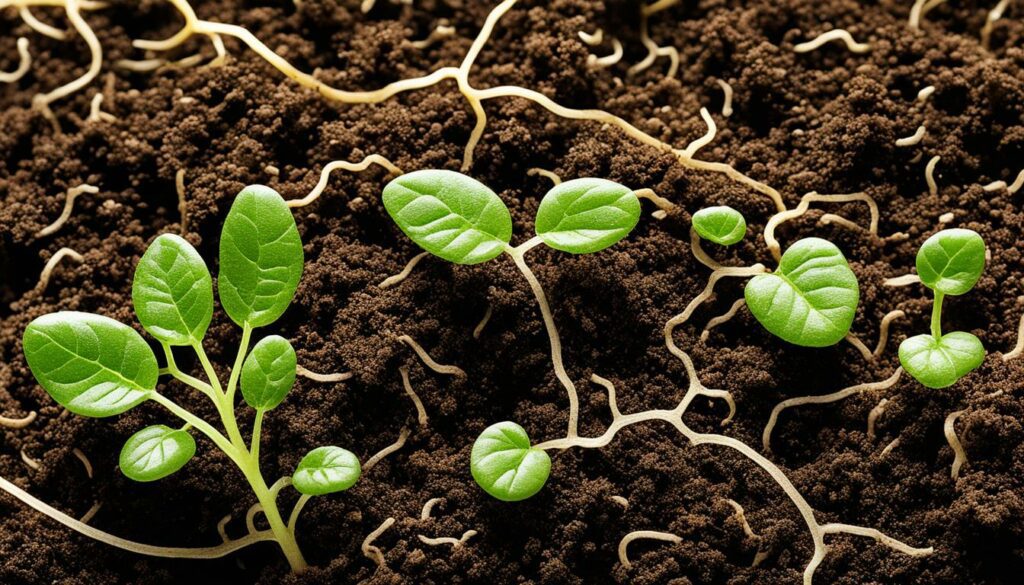
These advancements are key for protecting our soil. For example, designed crops can resist pests and diseases. This means we use fewer harmful chemicals that might harm water. In the US, most corn, cotton, and soybean crops are biotech. This was shown in a report from the USDA’s National Agricultural Statistics Service (NASS).
Farming also benefits from herbicides that are safer for the environment. These herbicides break down easily and harm little wildlife or people. Our farming methods become more eco-friendly. This is important as the world’s population grows towards 10 billion by 2050.
Biotechnology helps keep our soil working well. It changes how we see farming and nature working together. This moves us towards a future where farming and the environment help each other flourish. It is really about creating a balance.
| Crop | Biotechnology Adoption (%) |
|---|---|
| Corn | 88% |
| Cotton | 94% |
| Soybean | 93% |
By 2050, the world’s population will approach 10 billion. This brings immense pressure on agriculture to meet food needs sustainably. The worldwide push for sustainable agriculture fits well with biotechnology’s aims. It gives farmers a chance to boost soil health in a way that’s efficient and affordable. Through precision agriculture, biocontrol agents, and genetically modified organisms, they can ramp up soil fertility and crop output.
To improve soil health, farmers need to use various biotechnological tactics. Precision agriculture is crucial. It allows farmers to adjust their fields based on crop differences. This means they can apply nutrients accurately, improving soil health. They should also use biocontrol agents like helpful bacteria and fungi. These agents fight off soil diseases and help plants grow better, supporting a healthy soil condition. Lastly, the use of genetically modified organisms means crops can do well even in tough environments.
While starting with biotechnology can be expensive, the benefits in the long run are huge. It helps cut down on things like fertiliser and pesticide costs. This is because it allows for more specific and effective use of these materials. And higher agricultural output thanks to biotech means better incomes for farmers. Also, sustainable farming methods improve soil quality, reducing damage over time. This ensures fruitful farms for the future, benefiting both crops and the environment. So, these methods support healthier and more sustainable farming.
| Strategy | Benefits |
|---|---|
| Precision Agriculture | Improves nutrient management, enhances crop yields |
| Biocontrol Agents | Suppress pathogens, promote plant growth |
| Genetically Modified Organisms | Enable robust growth, adapt to challenging conditions |
| Zero Budget Natural Farming (ZBNF) | Adopted by over 50 lakh farmers in India, reduces input costs |
Biotechnology offers many benefits for soil health. But, there are significant challenges it faces. The public often sees biotechnology with doubt, worried about genetically modified organisms and their effects on the environment.
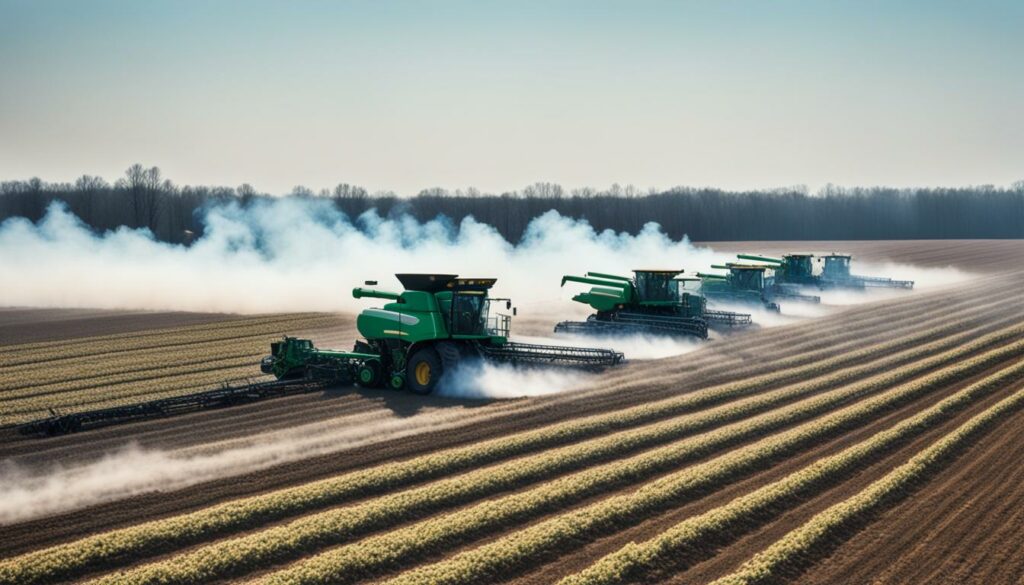
To change these views, open communication is key. Scientists must show clear evidence on biotech’s safety and success. In the USA, crops like genetically modified Bt corn and glyphosate-resistant soybeans are common. Yet, concerns about genetic engineering’s risks still linger.
Improving how people see biotech involves educating them. It’s important to explain the thorough tests and checks these crops go through. The approval of twelve transgenic crops, like corn and soybeans, after detailed scrutiny backs up the safety.
Real examples of biotech success also help change minds. The work at the University of Hawaii and Cornell, for instance, created virus-resistant papaya. This directly helped farms and proved the value of biotechnology.
| Biotechnological Achievement | Impact |
|---|---|
| Bacillus thuringiensis (Bt) Crops | No significant harm to soil decomposer communities |
| Herbicide Tolerant (HT) Crops | Largest area planted globally in 2018 (88.7 million hectares) |
| Genetic Engineering of Papaya | Resistance to papaya ringspot virus, benefiting crop resilience |
| Production of Chymosin | Used in 60% of cheese manufacturing, safer and more effective than traditional methods |
To truly tackle these challenges, we need a combined effort. This includes clear science, strong policies, and engaging with the public. By making everyone more scientifically informed, we can create a future where biotechnology supports sustainable agriculture.
Looking at successful cases with soil health biotech shows us world-wide wins. It teaches us how biotech can fix soil issues and boost farming. These stories show the power of using new tech to make better soil.
In the USA, using biotech has helped restore dry areas. They used special bacteria to form a layer on the ground. This layer helps with stopping soil from washing away and making the soil and water healthier. Israel and China also found success with biotech in different environments.
Biotechnology has had great results in making soil more fertile and fixing drylands. Methods like synthetic biology have made these efforts stronger. They’ve improved the health of our soil. These examples prove that biotech can change farming for the better.
We’ve learned a lot from biotech around the world. Making enough of the right bacteria for the soil is tough. It’s important to plan well when putting these bacteria into the environment. And it takes time for the soil to really start working better.
Learning from these biotech stories tells us something important. We must customise biotech plans to fit each area’s needs. This keeps our efforts strong over time, helping us succeed everywhere.
| Region | Approach | Outcomes |
|---|---|---|
| USA | Biocrust-forming Cyanobacteria | Improved Soil Fertility, Reduced Erosion, Enhanced Water Infiltration |
| Israel | Dryland Biocrust Rehabilitation | Increased Soil Stability, Enhanced Plant Establishment |
| China | Synthetic Biology Applications | Enhanced Nitrogen Cycling, Accelerated Land Recovery |
To wrap up, global biotechnology wins in soil health are a big deal. They show how tech can change the game in farming. By learning and doing more, we can make our soil and farms better for tomorrow.
Looking ahead, the future of biotechnology in soil health is bright. New innovations are set to change farming, such as better biofertilizers, precise farming tech, and gene editing. These soil health innovations will boost farm yields and be kinder to our planet.
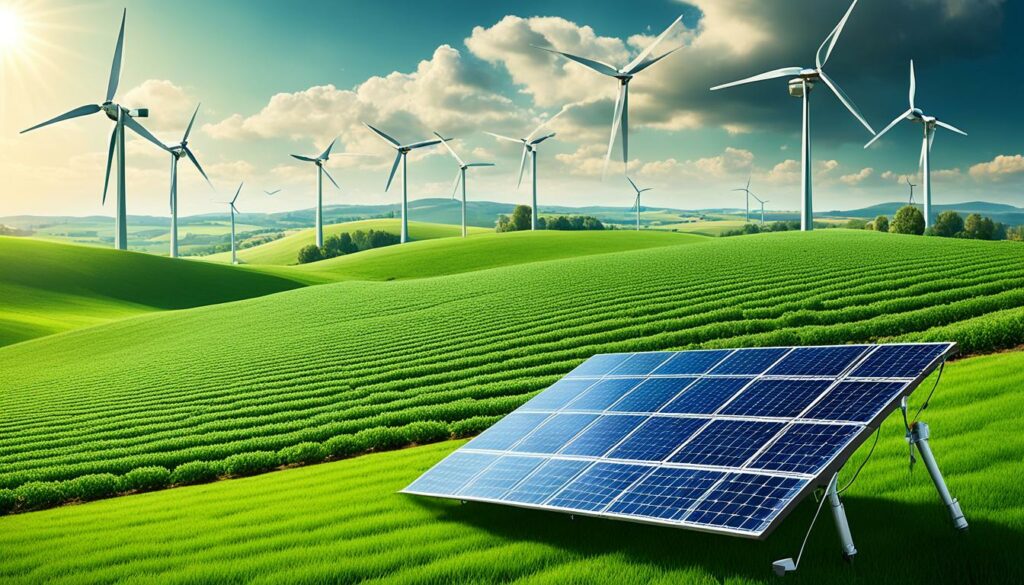
Biofertilizers catch our eye in biotechnology’s future, as they could cut chemical use by 25% without affecting crops. Precision farming will allow farmers to use nutrients wisely, cutting waste. Excitingly, gene editing with CRISPR could make crops tougher against bugs and sickness, perhaps reducing big losses by nearly 80%.
The societal impacts of biotech could be huge. They might change how we eat, making food more secure and farmers’ lives better. Studies show many people are ready to pay more for eco-friendly food, showing a big shift towards being green. In places like the US, Germany, and Sweden, folks are also happy to pay extra for eco-friendly packaging. This shows a growing want for earth-safe products, which biotech soil tech can help with.
More land being used for organic farming, with China at number three in 2018, shows a big move towards green farming. These steps indicate a strong future for soil health biotech, boosting sustainable farming practices. This helps everyone and the planet.
Government policies play a key role in advancing and controlling biotechnology use on soil health. They make sure that biotech methods are safe and don’t harm the environment. These rules keep up with the changes in biotechnology, protecting both people and nature.
The USDA uses guidelines to watch over how genetically engineered (GE) organisms are used. The Agricultural Plant Health Inspection Service (APHIS) at the USDA looks into plants’ import, movement, and release. They check how GE plants might affect non-GE plants and the environment.
Under President Trump, however, the USDA made some changes. It lessened the rules for GE crops, which caused more herbicide use. This made some weeds tough to kill. There’s also been less checking on some GE crops, which could spread without control.
Rules on biotechnology differ across the world. The EU is very careful, considering consumer safety a top priority. On the other hand, Brazil and Argentina are more flexible, which has led to agricultural innovation. These rules aim to keep people safe while allowing biotech to grow.
It’s crucial for leaders, experts, and the public to work together on biotech regulations. By improving global rules, we can tackle environmental and health worries. This way, we can support farming growth and new ideas. Keeping the door open for science and public talk is key for the future of biotech in farming.
Biotechnology is set to change how we take care of our soil, aiming for more sustainable farming. Studies have shown a big jump in our knowledge, from 120% to 150%, in understanding soil health. This makes it possible to make farming more eco-friendly.
Efforts to prevent water pollution in farming are also very important. For better soil protection, Europe needs to work on its rules, according to Stankovics and others in the Sustainability paper. Using certain natural methods, we can fight against harmful nitrates and pesticides in the water.
Biotechnology helps clean up water and makes soil healthier too. Thanks to healthy soil, we could see improvements in water quality by 10% to 15%. Also, systems like bioretention can make treating stormwater up to 40% more effective. This proves the broad environmental benefits of biotechnology.
Dealing with people’s worries about biotechnology is key. Studies note little risk from changing plants’ genetics. Farmers use these new crops to cut down on chemicals and make crops stronger. The FAO suggests looking at each case carefully to make sure what we do is both safe and helpful. As technology advances, the future of sustainable farming with biotech looks promising.
Biotechnology in soil health means using science and technology to improve the soil. It uses living things to make the soil better for plants. This makes sure the soil can stay healthy for a long time.
The benefits are better crop growth, stronger plants that can fight off pests and diseases, and less harm to the environment from chemicals. It also helps in managing the soil well, making farming more sustainable.
Genetic engineering changes the genes of plants. This makes the plants stronger against pests and harsh environments. It helps the soil stay healthy by protecting the plants, allowing them to grow better.
Many different tiny organisms in the soil help in many ways. They help plants grow, break down dead plants, and stop diseases. This helps the soil to stay strong against harm and changes.
Biotechnology encourages practices that are good for the earth. It uses natural ways to grow plants and fight off pests. This keeps the soil and the environment safe, making farming last a long time.
Soil biotechnology makes the soil full of helpful microbes and improves plants through genes. This boosts how much and how well crops can grow. It means we can grow more food that is better for us in a way that’s good for the planet.
By using less chemicals and saving water, soil biotechnology helps the environment. Plants with changed genes need fewer harmful sprays. Also, it helps use water better, so we have more for the future.
Farmers can use high-tech farming, friendly bugs to protect plants, and special plants that fight off pests. These modern ways aren’t hard on the budget and they keep the land and the plants healthy for a long time.
Some people worry about new farming ways that change how plants grow. They are concerned about possible bad effects on health and the environment. To ease these worries, we must talk openly, teach the public, and prove that biotech farming is safe and good for all.
There are successful stories showing how farming with biotechnology is good. Farms grow more food that is rich in nutrients and keep more plant and animal types alive. These stories teach us to think carefully and do more research to keep farming and nature healthy.
The future looks bright with better biofertilizers, smart farming tech, and new ways to change plant genes. These new tools will change the way we produce food, making it safer and helping farmers around the world.
Governments have rules to make sure farming with biotech is safe and works well. These rules are different in each country but aim to keep us and the world safe, while also encouraging new ideas in farming.